
Danish is a North Germanic language spoken by about six million people, principally in and around Denmark. Communities of Danish speakers are also found in Greenland, the Faroe Islands, and the northern German region of Southern Schleswig, where it has minority language status. Minor Danish-speaking communities are also found in Norway, Sweden, the United States, Canada, Brazil, and Argentina.
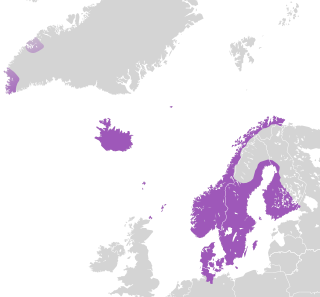
The Kalmar Union was a personal union in Scandinavia, agreed at Kalmar in Sweden, that from 1397 to 1523 joined under a single monarch the three kingdoms of Denmark, Sweden, and Norway, together with Norway's overseas colonies.

Scandinavia is a subregion in Northern Europe, with strong historical, cultural, and linguistic ties between its constituent peoples. Scandinavia most commonly refers to Denmark, Norway, and Sweden. It can sometimes also refer more narrowly to the Scandinavian Peninsula. In English usage, Scandinavia is sometimes used as a synonym for Nordic countries. Iceland and the Faroe Islands are sometimes included in Scandinavia for their ethnolinguistic relations with Sweden, Norway and Denmark. While Finland differs from other Nordic countries in this respect, some authors call it Scandinavian due to its economic and other similarities.

The Great Northern War (1700–1721) was a conflict in which a coalition led by the Tsardom of Russia successfully contested the supremacy of the Swedish Empire in Northern, Central and Eastern Europe. The initial leaders of the anti-Swedish alliance were Peter I of Russia, Frederick IV of Denmark–Norway and Augustus II the Strong of Saxony–Poland–Lithuania. Frederick IV and Augustus II were defeated by Sweden, under Charles XII, and forced out of the alliance in 1700 and 1706 respectively, but rejoined it in 1709 after the defeat of Charles XII at the Battle of Poltava. George I of Great Britain and the Electorate of Hanover joined the coalition in 1714 for Hanover and in 1717 for Britain, and Frederick William I of Brandenburg-Prussia joined it in 1715.
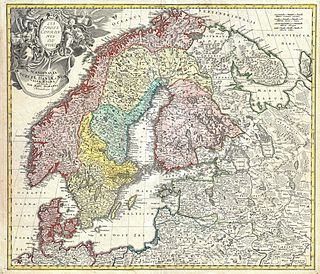
The history of Denmark as a unified kingdom began in the 8th century, but historic documents describe the geographic area and the people living there—the Danes—as early as 500 AD. These early documents include the writings of Jordanes and Procopius. With the Christianization of the Danes c. 960 AD, it is clear that there existed a kingship. Queen Margrethe II can trace her lineage back to the Viking kings Gorm the Old and Harald Bluetooth from this time, thus making the Monarchy of Denmark the oldest in Europe. The area now known as Denmark has a rich prehistory, having been populated by several prehistoric cultures and people for about 12,000 years, since the end of the last ice age.

The Øresund or Öresund Bridge is a combined railway and motorway bridge across the Øresund strait between Denmark and Sweden. It is the longest in Europe with both roadway and railway combined in a single structure, running nearly 8 kilometres from the Swedish coast to the artificial island Peberholm in the middle of the strait. The crossing is completed by the 4-kilometre (2.5 mi) Drogden Tunnel from Peberholm to the Danish island of Amager.

Denmark is a Nordic country in Northern Europe. It is the metropolitan part of and the most populous constituent of the Kingdom of Denmark, a constitutionally unitary state that includes the autonomous territories of the Faroe Islands and Greenland in the North Atlantic Ocean. Metropolitan Denmark is the southernmost of the Scandinavian countries, lying south-west and south of Sweden, south of Norway, and north of Germany, with which it shares a short border, Denmark's only land border.
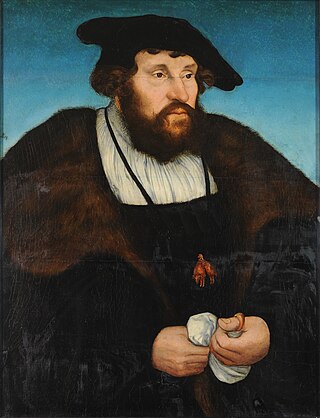
Christian II was a Scandinavian monarch under the Kalmar Union who reigned as King of Denmark and Norway, from 1513 until 1523, and Sweden from 1520 until 1521. From 1513 to 1523, he was concurrently Duke of Schleswig and Holstein in joint rule with his uncle Frederick.

Christian IV was King of Denmark and Norway and Duke of Holstein and Schleswig from 1588 until his death in 1648. His reign of 59 years, 330 days is the longest of any Danish monarch.
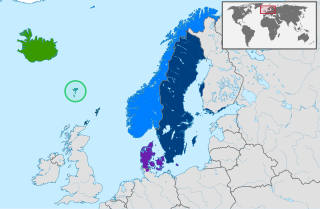
The North Germanic languages make up one of the three branches of the Germanic languages—a sub-family of the Indo-European languages—along with the West Germanic languages and the extinct East Germanic languages. The language group is also referred to as the Nordic languages, a direct translation of the most common term used among Danish, Faroese, Icelandic, Norwegian, and Swedish scholars and people.

Christian I was a German noble and Scandinavian monarch under the Kalmar Union. He was king of Denmark (1448–1481), Norway (1450–1481) and Sweden (1457–1464). From 1460 to 1481, he was also duke of Schleswig and count of Holstein. He was the first king of the House of Oldenburg.

Sweden and Norway or Sweden–Norway, officially the United Kingdoms of Sweden and Norway, and known as the United Kingdoms, was a personal union of the separate kingdoms of Sweden and Norway under a common monarch and common foreign policy that lasted from 1814 until its peaceful dissolution in 1905.

The Treaty of Roskilde was negotiated at Høje Taastrup Church and signed (NS) during the Second Northern War between Frederick III of Denmark–Norway and Karl X Gustav of Sweden in the Danish city of Roskilde. After a devastating defeat, Denmark–Norway was forced to give up a third of its territory to save the rest, the ceded lands comprising Blekinge, Bornholm, Bohuslän (Båhuslen), Scania (Skåne) and Trøndelag, as well as her claims to Halland.

The Treaty of Kiel or Peace of Kiel was concluded between the United Kingdom of Great Britain and Ireland and the Kingdom of Sweden on one side and the Kingdoms of Denmark and Norway on the other side on 14 January 1814 in Kiel. It ended the hostilities between the parties in the ongoing Napoleonic Wars, where the United Kingdom and Sweden were part of the anti-French camp while Denmark–Norway was allied to France.

Helsingborg is a city and the seat of Helsingborg Municipality, Scania (Skåne), Sweden. It is the second-largest city in Scania and ninth-largest in Sweden, with a population of 113,816 (2020). Helsingborg is the central urban area of northwestern Scania and Sweden's closest point to Denmark: the Danish city Helsingør is clearly visible about 4 km (2.5 mi) to the west on the other side of the Øresund. The HH Ferry route across the sound has more than 70 car ferry departures from each harbour every day.

The Scanian War was a part of the Northern Wars involving the union of Denmark–Norway, Brandenburg and Sweden. It was fought from 1675 to 1679 mainly on Scanian soil, in the former Danish–Norwegian provinces along the border with Sweden, and in Northern Germany. While the latter battles are regarded as a theater of the Scanian war in English, Danish, Norwegian and Swedish historiography, they are seen as a separate war in German historiography, called the Swedish-Brandenburgian War.

Sweden, formally the Kingdom of Sweden, is a Nordic country located on the Scandinavian Peninsula in Northern Europe. It borders Norway to the west and north, Finland to the east, and is connected to Denmark in the southwest by a bridge–tunnel across the Öresund. At 447,425 square kilometres (172,752 sq mi), Sweden is the largest Nordic country, the third-largest country in the European Union, and the fifth-largest country in Europe. The capital and largest city is Stockholm. Sweden has a total population of 10.5 million, and a low population density of 25.5 inhabitants per square kilometre (66/sq mi), with around 87% of Swedes residing in urban areas, which cover 1.5% of the entire land area, in the central and southern half of the country.

The relations between Denmark and Sweden span a long history of interaction. The inhabitants of each speak related North Germanic languages, which have a degree of mutual intelligibility. Both countries formed part of the Kalmar Union between 1397 and 1523, but there exists an inherited cultural competition between Sweden and Denmark. From 1448 to 1790 the two kingdoms went to war against each other at nearly every opportunity; in more than one case a new king tried to prove his worth by waging war on the other country for little or no political reason. Eleven Dano-Swedish wars took place between 1521 and 1814.

Denmark–Norway was an early modern multi-national and multi-lingual real union consisting of the Kingdom of Denmark, the Kingdom of Norway, the Duchy of Schleswig, and the Duchy of Holstein. The state also claimed sovereignty over three historical peoples: Frisians, Gutes and Wends. Denmark–Norway had several colonies, namely the Danish Gold Coast, the Nicobar Islands, Serampore, Tharangambadi, and the Danish West Indies. The union was also known as the Dano-Norwegian Realm, Twin Realms (Tvillingerigerne) or the Oldenburg Monarchy (Oldenburg-monarkiet).
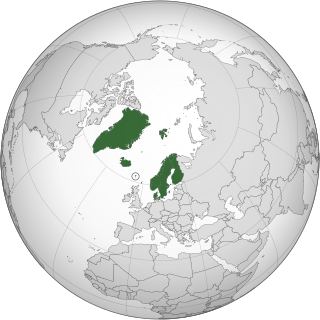
The Nordic countries are a geographical and cultural region in Northern Europe and the North Atlantic. It includes the sovereign states of Denmark, Finland, Iceland, Norway and Sweden; the autonomous territories of the Faroe Islands and Greenland; and the autonomous region of Åland.



















